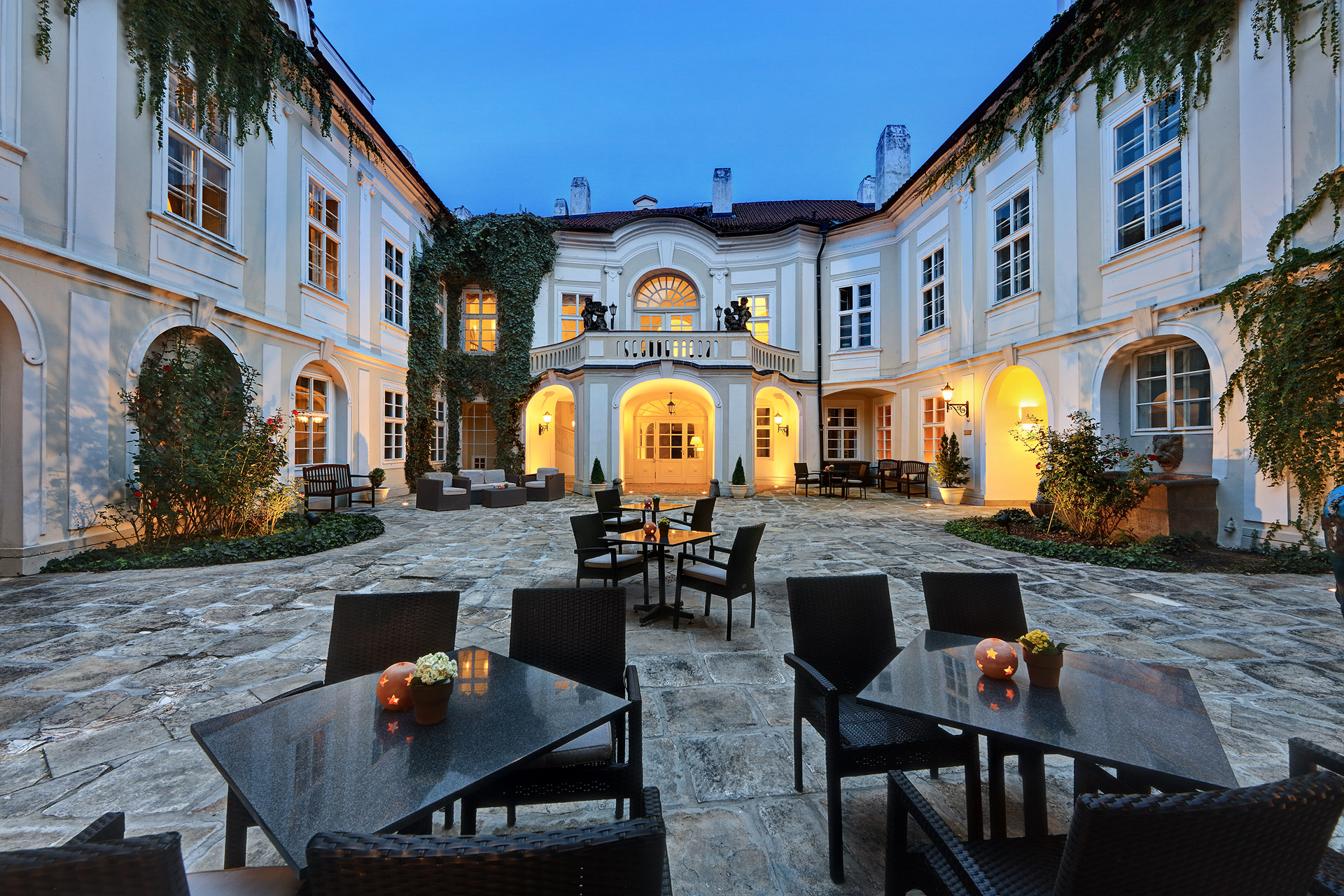Prague is such a city of history, culture, and art, that, though one can feel they know it’s terrain very well, it continues to surprise and delight with its hidden gems on every visit. The Mozart is one of these well-kept treasures, residing quietly for centuries as an unassuming Baroque Palace steeped in history off Anenske Namasti. Though I know Prague well, and consider it almost home given my Czechoslovak origins, in a bid to escape England’s rain-filled summer, and the stresses of my day-to-day, the palace became my retreat for the weekend. That I chose not to leave my suite for the entire duration of my stay (besides dinner and breakfast), is a testimony to the palace’s ability to refresh and recharge with its air of unassuming decadence.
Located just across the Charles Bridge on the river Vltava, with the Old Town Square a lazy 10 minute stroll away, and Prague Castle less than 20 minutes, the palace’s location is unparalleled. Its proximity to the river grants it an air of spaciousness and peace as it sits on the outskirts of Prague’s tourist-ridden squares and alleyways, whilst its being so near to Charles Bridge means cafes, restaurants and shops remain a stone’s throw away.
The original Baroque palace belonged to Earl Hubert Karel Pachta, a noble family originating back to the 1600s. Interestingly, the family’s original coat of arms, which can be seen on the front of the palace’s entrance, were bequeathed to them by Franz Ferdinand himself in 1628. The current estate constitutes of two separate houses, the original Baroque palace built by Jan Josef Wirch, with its original rooms, and The Mozart, a newer part of the hotel with a river view. Between these medieval and neoclassical building, there are in total there are 49 rooms, rendering it very much a boutique hotel. Brilliantly (yet tastefully), every room, corridor, and courtyard harks back to its bygone era, featuring gloriously high vaulted ceilings, artwork, statues, and authentic furnishings. The overwhelming sense of the vast space is of retired history, a private place to retreat to and rest in.
It is not only the palace’s architecture and design that brings delight to its visitors, but also the stories of its previous the guests: Wolfgang Amadeus Mozart and his wife Konstanze were regular guests of the Count, as were fellow composers Ludwig Van Beethoven and Richard Wagner, as well as, quite unexpectedly, Casanova. The suites in the original Baroque palace are oft named after these iconic visitors. The Mozart Suite, for example, is the original room where Mozart was symbolically imprisoned by the Count for having promised to compose a few dance pieces for him, and is thus the very room where his 6 German Dances, K. 509 were composed. Quite the name-drop for those staying there. Inevitably, the rooms are all decorated individually with unique features, appearing in reverence for their muses.
Aside from the 49 beautiful rooms, there are two restaurants, Cafe La Creme, where breakfast is served, and Atelier Kalina, where Michelin style fine dining takes place. There is no on-site spa but a range of Sisley treatments in a small on-site Sisley Institute, and in-room massages can be arranged, as can picnic baskets upon request. There is, wonderfully, a relaxed outdoor courtyard to enjoy al fresco dining, as well as an unexpected Cigar Chapel – a sophisticated cigar smoking room set in what used to be the palace’s 17th century chapel from 1628.
Collected at the airport by the palace’s pick up service, I arrived to the palace to be greeted warmly by Radek, the hotel director and operations manager, whose graciously generous hospitality made me feel immediately at home. Feeling as if I were in a 19th century English Abbey, I made my way to the third floor towards the Charles Suite where I was staying. Overlooking its namesake, the Charles Bridge, this spacious suite significantly exceeded any expectations we had. Featuring a vast double room with a majestic four-poster bed, an adjacent small living room with sofas and television, and large bathroom, this suite felt more like a London apartment than a hotel. Its stately furnishings, redolent of its bygone era, high ceilings, and tasteful artwork, harbour a reticent style that leaves the room feeling subdued and soothing. Feature wise, the large bathroom had a decent sized bathtub, L’Occitane toiletries, and Sinjay facilities in the shower. The Mozart is the first hotel in Prague to feature this innovative shower system, which is essentially a natural oil blast in the shower that smothers your body with delicious fragrances. The room also came with two large TVs, and a minibar, as well as an excellent espresso machine, and decent sized kitchenette with a hob, fridge and sink. This really is a first class home away from home, and it is no wonder that I decided to spend two full days lounging lazily on my chaise lounge, reading, sipping coffee, bathing, and resting myself.
After an excellent night’s sleep, undisturbed by the busy promenade outside thanks to the well-glazed windows, my guest and I made our way to the breakfast in the casual Cafe La Creme. Decorated in manner of a classic French cafe (imported from the now-closed Hotel Lutetia in Paris), it features indoor and outdoor seating with river views. Open all day with an international menu of salads, soups, and burgers, this sunshine-filled cafe is also open for breakfast to outside guests, rendering the ambience pleasantly social. The breakfast selection is simple, as reticent as the hotel’s ambience, yet as high quality as the rest of the Palace. There is a selection of home-made breads, including different varieties of wholegrain, nutty, and sourdough Czech loaves, fresh buttery croissants, jams, and excellent coffees. One is also able to order a la carte, as we did, from a decent menu of local organic barn eggs, more traditional Czech dishes of local sausages and meats, healthy varieties like granola and coconut yogurt, and also smoothies. The first morning, after two excellent lattes, my guest ordered the granola with fresh fruit and yogurt, whilst I had an exceptional Eggs Benedict with ham and smoked salmon. The second morning, we both opted for scrambled eggs with salmon, spinach, and crème fraîche, as well as a green smoothies that were brilliantly rejuvenating after a somewhat heavy evening of wine and food.
The hotel also offer tours and sight-seeing with their own local guides. On the second day, we were fortunate enough to have a private tour by the hotel director Radek, before our dinner at Atelier Kalina, the fine dining restaurant of the hotel. A warm and flattering gentleman with a deliciously reserved wit fit to keep us giggling for hours, Radek took us across the Charles Bridge, telling us the history of the hotel, before showcasing a few secret spots for us to sample. The sense of relaxation and ease that he added to our stay, ensured it was a happy two hours, and I would recommend any guest to request a tour if they are so able to.
Upon the morning of day three, it was time to leave, and we were, surprisingly sad to do so. The Mozart was an unexpectedly superb stay – with everything from its grand rooms, to the meticulous service from Radek and his team, to the delicious food in Atelier Kalina (see my food review), and Cafe Creme. This is a stately hotel I will remember fondly for a very long time. I would be delight to return – and highly recommend you try it.
The Mozart
Smetanovo Nábřeží 20
Prague 1, Prague, 110 00
Czech Republic


